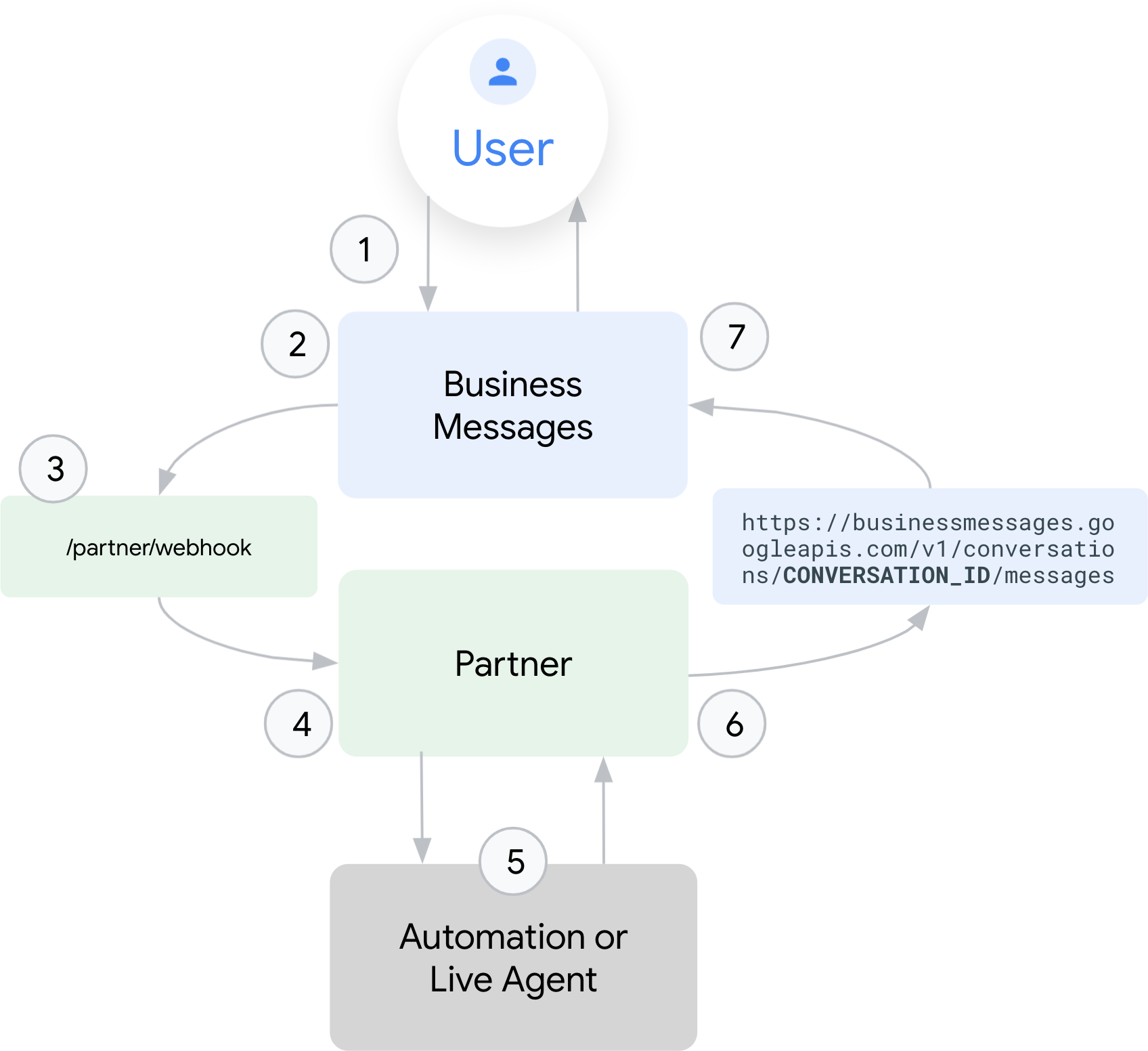ユーザーはエージェントにメッセージを送信できます。エージェントはユーザーにメッセージを送信できますが、それ以上のものがあります。メッセージごとに、多くの関係者が関与することがあります。
- ユーザーは、検索、マップ、ブランド管理型のリンクやウェブサイトのエントリ ポイントを使用して、エージェントとの会話を開始します。ユーザーは Google アカウントにログインする必要がありますが、ユーザー名のみがパートナーと共有されます。ユーザー メッセージは TLS で暗号化されます。
ビジネス メッセージは、ユーザーとパートナーの間のレイヤとして機能し、ユーザーのプライバシーを保護します。このレイヤは、各受信メッセージと送信メッセージを復号して再暗号化し、ユーザーの Google アカウントを会話 ID にマッピングすることで、ユーザーの Google アカウント情報がパートナーまたはライブ エージェントと共有されないようにします。
Google では、暗号化されたメッセージをユーザーのデバイス間で配信、同期できるように保存しています。これらの保存済みメッセージは第三者と共有できません。アクセスできるのは、お客様の Google ID のみです。
エージェントは、パートナーが作成し、管理しているブランドを表します。
パートナー様は、ブランドを代理してエージェントを管理します。パートナーは、指定された Webhook で受信メッセージを受信し、受信メッセージを自動化エージェントまたは人間のエージェントにルーティングして、レスポンスを作成して、Business Messages API に送信します。
自動化は、人間の介入なしにユーザー メッセージを処理します。
人間のエージェントは人間による対応が必要なユーザー メッセージを処理します。
各当事者は会話内でメッセージの送受信を行います。エンドツーエンドのメッセージング フローは、ユーザーがエージェントにメッセージを送信することから始まり、ユーザーはエージェントからレスポンスを受け取ります。

- ユーザーが会話を開始し、ビジネス メッセージ エージェントにメッセージを送信します。
- ビジネス メッセージでは、会話に ID が割り当てられます。会話 ID は永続的であり、ユーザーとエージェントに対して一意です。同じユーザーが別のエージェントと接触した場合、その会話は別の会話 ID を持つことになります。
- ビジネス メッセージは、暗号化されたメッセージをパートナーの Webhook に送信します。メッセージには、一意の会話 ID、エージェント ID、メッセージ ID、会話が発生したコンテキスト情報が含まれます。
- パートナーは、メッセージを受信し、メッセージを自動エージェントまたはライブ エージェントに転送します。
- 自動化により、ユーザー メッセージに対するレスポンスが自動的に作成されます。会話にアクセスできるライブ エージェントがユーザー メッセージを確認して、それに応じてレスポンスを作成します。
- パートナーは、会話 ID を受信者として、Business Messages API にレスポンスを送信します。
- ビジネス メッセージは、メッセージの復号と再暗号化、会話 ID とユーザーの Google アカウントのマッピング、ユーザーへのメッセージの送信を行います。
